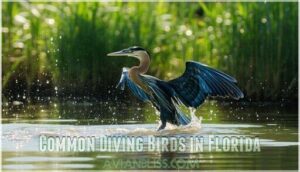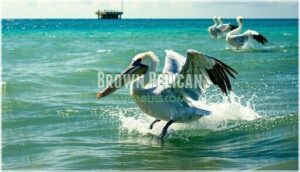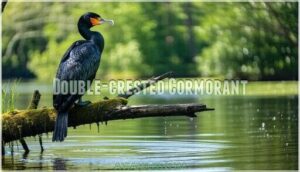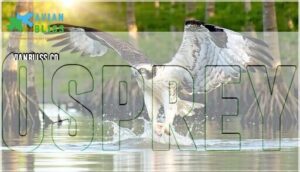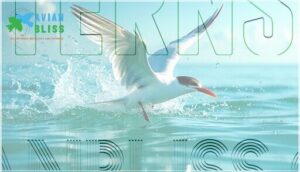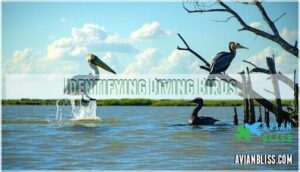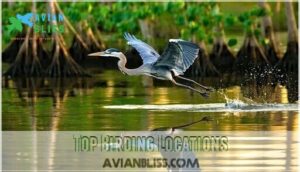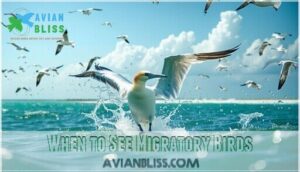This site is supported by our readers. We may earn a commission, at no cost to you, if you purchase through links.

These aquatic athletes include Double-crested Cormorants that can hold their breath for a full minute, lightning-fast Ospreys snatching fish with surgical precision, and elegant terns that arrow into the water like feathered missiles.
The Sunshine State’s diverse wetlands host eight distinct species, each perfectly adapted for their fishing lifestyle.
Whether you’re cruising the Everglades or walking Gulf Coast beaches, these natural acrobats put on quite a show.
Timing and location make all the difference for spotting specific species.
Table Of Contents
Key Takeaways
- You’ll find eight distinct diving bird species in Florida year-round, including Brown Pelicans with their dramatic headfirst plunges, Anhingas that swim underwater like submarines, and Ospreys that snatch fish with surgical precision.
- You can spot these birds at prime locations like Merritt Island National Wildlife Refuge, Fort De Soto Park, and the Everglades, where diverse wetlands provide perfect hunting grounds for both coastal and freshwater species.
- You’ll have the best viewing opportunities during peak migration seasons – spring (mid-March through late April) and fall (August through October) – when northern species like Common Loons join Florida’s year-round residents.
- You can identify these diving birds by watching their unique behaviors: pelicans’ expandable throat pouches, cormorants’ distinctive wing-drying poses, anhingas’ spear-like fishing technique, and terns’ precision plunge-diving from heights up to 50 feet.
Common Diving Birds in Florida
The thrill of spotting your first diving bird in Florida never gets old.
Florida’s diving birds turn every waterway into nature’s greatest theater production.
You’ll encounter incredible species like anhingas, brown pelicans, double-crested cormorants, and ospreys throughout the state’s diverse waterways.
These Florida diving birds showcase remarkable diving adaptations that’ll leave you amazed – from the anhinga bird’s spear-like bill to pelicans’ expandable throat pouches.
Each species employs unique feeding strategies.
Anhingas stalk prey underwater like feathered submarines, while ospreys dive talons-first with pinpoint accuracy.
Their habitat preferences vary too – some prefer coastal waters, others favor freshwater lakes and rivers.
Florida bird species face conservation challenges from habitat loss and water quality issues, though population trends show encouraging recovery for many.
Common diving birds thrive here year-round, making diving bird identification an exciting adventure.
Whether you’re kayaking through mangroves or walking coastal boardwalks, these acrobatic hunters provide endless entertainment.
The state’s diverse waterways offer a perfect setting for spotting these birds, with their remarkable diving adaptations and unique behaviors.
With incredible species to discover, Florida is a paradise for bird enthusiasts, offering a chance to see feathered submarines and other amazing creatures in their natural habitat.
Brown Pelican
You’ll spot Florida’s most iconic seabird performing spectacular aerial shows along every coastline.
The Brown Pelican’s diving technique is pure poetry in motion—they plunge headfirst from 30 feet high, tucking their wings back like feathered missiles.
Their expandable throat pouch can hold up to three gallons of water and fish, making them incredibly efficient hunters.
These seabirds Florida residents love gather in coastal colonies, especially around St. Augustine Pier where you can watch their skimming behavior as they glide just inches above the waves.
Adult plumage changes dramatically during breeding season, transforming from dull brown to striking white and chestnut patterns.
Here’s the amazing part: Brown Pelicans represent one of conservation’s greatest success stories.
DDT nearly wiped them out in the 1960s, but protection efforts brought them back from the brink.
Today, these coastal birds Florida showcases prove that dedicated conservation works.
When you’re doing diving bird identification, their massive size and distinctive pouched bills make them unmistakable.
Double-crested Cormorant
While Brown Pelicans steal the spotlight along Florida’s coast, the Double-crested Cormorant quietly masters underwater hunting in both saltwater and freshwater environments.
These sleek diving birds, Florida residents often mistake for small geese, pack serious fishing skills beneath their modest appearance. You’ll spot these Florida waterbirds by their jet-black feathers and distinctive wing drying behavior—they’ll perch motionless with wings spread wide like they’re air-drying laundry.
Their hooked bills and webbed feet make them perfect underwater missiles, chasing fish through murky waters with surprising agility.
Here are 5 identification tips that’ll make you a cormorant-spotting pro:
- Bright orange throat patch that glows like a tiny sunset
- Double head crests during breeding season (hence the name!)
- Snake-like neck that curves gracefully while swimming
- Distinctive wing drying poses after every fishing session
- Colonial nesting habits in trees near water
These aquatic birds, Florida calls home, survived the DDT crisis and now thrive despite occasional fishing conflicts with anglers. Their remarkable DDT rebound proves nature’s resilience when given a fighting chance.
Anhinga
When you see an Anhinga spreading its wings to dry after diving, you’re witnessing Florida’s "snakebird" in action.
These diving birds Florida residents love inhabit wetland habitat like the Everglades, where their underwater hunting skills shine.
Unlike other aquatic birds Florida hosts, Anhingas spear fish with lightning-fast neck strikes. Their Anhinga diet includes catfish and sunfish.
As members of the darter family, they share ancestry with similar birds in Asia, Africa, and Australia.
Nesting behavior involves colonial tree nests near water. Conservation status remains stable, making these remarkable Florida waterbirds a reliable sight for Florida wildlife enthusiasts year-round.
Osprey
Florida’s magnificent osprey commands attention with its six-foot wingspan and deadly accurate fishing techniques.
You’ll watch these aquatic birds Florida residents love as they plunge feet-first into water, reversing their outer toes to grip slippery fish.
Their osprey diet consists almost entirely of fish, making Florida wildlife viewing spectacular.
These diving birds Florida showcases build massive stick nests on power poles and trees.
Conservation status remains stable thanks to artificial nesting platforms.
Perfect for birdwatching Florida enthusiasts, ospreys demonstrate nature’s incredible habitat range adaptability.
They’re found across the globe, except for Antarctica.
Terns
You’ll recognize terns by their sleek bodies and sharp beaks as they hover above the water before plunging headfirst to snatch fish below the surface.
These graceful acrobats of the air include Florida’s impressive Forster’s Tern and the massive Caspian Tern, both masters of precision fishing that’ll make you stop and watch their aerial show.
Forster’s Tern
Watching Forster’s Tern navigate Florida’s coastal waters feels like witnessing pure poetry in motion.
This medium-sized diving bird measures 13-14 inches with distinctive red legs and a black-tipped bill that makes Forsters ID straightforward for birdwatching Florida enthusiasts.
You’ll spot these graceful Florida birds performing shallow plunge-dives to snatch small fish, their primary diet.
Their habitat range includes marshes, estuaries, and coastal areas throughout the state during winter months.
Here’s what makes Forster’s Tern special among diving birds Florida:
- Breeding habits involve elaborate courtship feeding displays where males offer fish to potential mates
- Diet consists mainly of small fish like killifish and minnows, plus aquatic insects
- Conservation status remains stable thanks to protected Florida bird habitats
These talented hunters hover before diving headfirst with partially folded wings, making them a true spectacle for any birder exploring Florida’s diverse wetlands.
Caspian Tern
While Forster’s terns charm you with their delicate grace, Caspian terns command attention with their sheer size and power. These impressive diving birds Florida boasts represent the largest tern species in North America, making Caspian Tern ID relatively straightforward once you spot their distinctive orange-red bills and sturdy build.
Global Distribution spans across multiple continents, but Florida’s coastal waters provide ideal hunting grounds. These Florida water birds excel at precision fishing, plunging from heights up to 50 feet to snag their preferred prey.
Breeding Habits involve colonial nesting alongside other Florida Keys birds species. You’ll find them sharing space with:
- Black skimmers and royal terns in mixed colonies
- Great blue herons in protected rookeries
- Brown pelicans on secluded islands
Conservation Status remains stable, though habitat protection in Florida bird habitats stays critical. Their Diet Analysis reveals a preference for larger fish than other terns, showcasing their remarkable diving prowess in these pristine waters.
Northern Gannet
These magnificent seabirds arrive in Florida’s coastal waters each winter, bringing spectacular diving displays.
You’ll spot Northern Gannets plunging from 100 feet at 60 mph speeds – their diving technique is unmatched among Florida birds.
Their migration patterns bring them south from Canadian nesting habits to warmer pelagic waters.
Watch for their distinctive white bodies and black wingtips during gannet identification.
Despite stable conservation status, they face modern threats like plastic ingestion and fishing gear entanglement.
| Dive Stats | Physical Traits | Winter Behavior |
|---|---|---|
| 100+ feet high | 6-foot wingspan | Coastal waters only |
| 60 mph speed | Bright white body | Follows fish schools |
| 72 feet deep | Black wingtips | Rarely seen inland |
| 10-20 seconds surface | Sharp, pointed bill | Peak activity at noon |
Identifying Diving Birds
When identifying diving birds Florida offers, you’ll quickly discover each species has distinct calling cards. Size comparison helps distinguish massive Brown Pelicans from smaller Piedbilled Grebes.
Watch flight patterns—Anhingas glide with cross-shaped silhouettes while Doublecrested Cormorants fly in formation. Plumage variations change seasonally, so note breeding colors versus winter feathers.
Underwater behavior differs too; some birds dive deep while others skim surfaces. * Listen for unique vocalizations—each species has signature calls
- Observe bill shapes: pointed daggers versus expandable pouches
- Note drying behavior after dives (non-waterproof feathers)
- Watch diving techniques: plunge-diving versus pursuit swimming
- Study neck positions during flight and swimming to understand their diving techniques and unique characteristics.
Top Birding Locations
Florida’s birding hotspots deliver incredible diving bird encounters across diverse landscapes.
Merritt Island National Wildlife Refuge showcases over 330 species along its 7-mile Black Point Wildlife Drive, while Fort De Soto Park’s Gulf Pier attracts migrating terns and pelicans.
J.N. "Ding" Darling’s mangrove estuaries and Everglades’ Snake Bight Trail offer prime anhinga viewing. These conservation areas balance accessibility factors with pristine habitats.
Coastal hotspots excel for seabirds, while inland sanctuaries provide freshwater species diversity.
Consider exploring various birding products to enhance your experience. Each location’s seasonal variations create unique birdwatching opportunities throughout Florida’s protected lands.
When to See Migratory Birds
Timing your bird watching adventures around Florida’s seasonal patterns makes all the difference.
Peak migration occurs during spring (mid-March through late April) and fall (August through October), when diving birds like Northern Gannets and various terns flood coastal waters.
Cold fronts create incredible fallouts at birding hotspots Florida offers, concentrating exhausted migrants at places like Dry Tortugas.
Weather impacts can either scatter birds or create spectacular viewing opportunities.
Follow this birding calendar: spring brings diversity, while fall delivers numbers that’ll blow your mind.
Check the Florida birding products for more resources.
Frequently Asked Questions (FAQs)
What diving birds are endangered in Florida?
Like ancient sentinels standing watch over disappearing kingdoms, you’ll find the Wood Stork reigns as Florida’s only federally endangered diving bird.
Its bald head and sharp bill hunting through shrinking wetlands with desperate precision.
How deep can Florida diving birds dive?
Most Florida diving birds reach depths between 3-10 feet, though some species like cormorants can dive deeper to 25 feet.
You’ll find brown pelicans staying shallow while anhingas venture deeper for fish.
Do diving birds migrate through Florida seasonally?
Yes, you’ll spot many diving birds migrating through Florida seasonally. Winter brings northern species like Common Loons and mergansers south, while summer sees others heading north for breeding.
What threats affect diving bird populations?
You’ll find that habitat loss, water pollution, and human disturbance pose the biggest threats to these amazing divers.
Fishing gear entanglement and coastal development also harm populations, making wetland protection essential for their survival.
Where do diving birds nest in Florida?
You’ll find diving birds nesting in colonies throughout Florida’s mangroves, coastal islands, and wetland trees.
They choose spots near water—both freshwater lakes and saltwater areas—where fish are plentiful for feeding their young, which is a complete concept for their survival.
Conclusion
Ready to become Florida’s next diving bird expert?
These eight remarkable species transform the state’s waterways into nature’s greatest aerial circus year-round.
From pelicans’ spectacular crashes to ospreys’ precision strikes, diving birds in Florida offer endless entertainment for patient observers.
Pack your binoculars, choose your season wisely, and head to prime locations like the Everglades or coastal beaches.
You’ll discover that watching these feathered athletes hunt isn’t just birdwatching—it’s witnessing millions of years of evolution in action.
- https://chipperbirds.com/diving-birds-in-florida/
- https://www.forwardpathway.us/ecological-roles-and-physiological-adaptations-of-florida-waterbirds
- https://flyaviary.com/types-of-water-birds-in-florida/
- https://birdgap.com/florida-birds-dive-fish/
- https://www.earth.com/news/floridas-waterbirds-expert-divers-with-bold-hunting-techniques/

